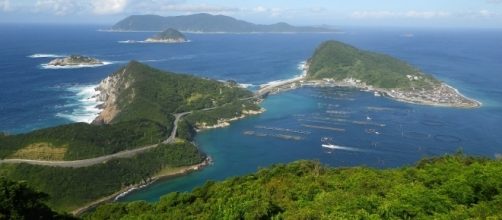The United Nations Educational, Scientific and Cultural Organization (UNESCO) announced the other day their World Heritage Site listings for 2017, including 22 different sites inscribed by the organization across 21 different countries and 4 different continents. However, the Japanese site that has been included, the "Sacred Island of Okinoshima and Associated Sites in the Munakata Region," has made all of the headlines.
What is the 'Sacred Island of Okinoshima
Okinoshina is located between the main Japanese island of Kyushu and the Korean Peninsula.
The 240-acre island, along with four other related sites and three nearby reefs were given UNESCO status. The island features a 17th century Shinto shrine, Okitsu, and was once a site of maritime safety rituals. It has also been the hub of relations and trade with China and Korea dating back to the 4th century AD. Some 80,000 items have been discovered on the island and it is home to a gigantic collection of artifacts.
Priests from a group of Shinto shrines called Munakata Taisha on Kyushu are permitted to travel to Okitsu tor worship. Aside from them, only 200 men are allowed to visit on May 27th to honor sailors who died at the Battle of Tsushima during the Ruso-Japanese War (1904-05). Before going ashore men must strip naked and undergo "misogi," where they bathe in the sea to remove impurities.
They are also not allowed to take anything from the island back home. The reason for women being banned from the island has never been publicly stated, though many theories exist. The chief priest at Munakata Taisha has stated that Okinoshima will remain closed to women and tourists, despite its new status.
What are the other new UNESCO sites?
Eight of the new UNESCO World Heritage Sites are in Asia, including the aforementioned "Sacred Island of Okinoshima." China is the only country with two new sites, "Kulangsu: a Historical International Settlement" and "Qinghai Hoh Xil." Rounding out the rest of the Asian/Middle Eastern sites: Turkey ("Aphrodisias"), Palestine ("Hebron/Al-Khalil Old Town"), India ("Historic City of Ahmadabad"), Iran ("Historic City of Yazd"), Mongolia ("Landscapes of Dauria") and Cambodia ("Temple Zone of Sambor Prei Kuk").
Europe also has eight new sites, including: "Assumption Cathedral and Monastery of the town-island of Sviyazhsk" (Russia), "Caves and Ice Age Art in the Swabian Jura" (Germany), "Kujataa Greenland: Norse and Inuit Farming at the Edge of the Ice Cap" (Denmark), "Primeval Beech Forests of the Carpathians and Other Regions of Europe" (Albania), "Taputapuatea" (France), "Tarnowskie Gory Lead-Silver-Zinc Mine and its Underground Water Management System"(Poland), the "English Lake District" (Great Britain) and "Venetian Works of Defense between the 15th and 17th centuries" (Croatia).
Africa has three new sites as well: "Asmara: a Modernist City of Africa" (Eritrea), "Mbanza Kongo" (Angola) and "Khomani Cultural Landscape" (South Africa). South America has two new sites as well, including: "Los Alerces National Park" (Argentina) and "Valongo Wharf Archaeological Site" (Brazil).


